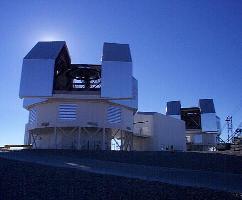
Photo of the Magellan Telescopes
Among the approximately 340 extra-solar planets known to date are 58 that were discovered because they transit their stars (that is, their orbits take them in front of their stars as seen from the earth). The inferred masses of these transiting planets are uncertain by amounts set principally by the measurements' signal-to-noise ratios and our knowledge of the parent star's mass, unlike planetary masses measured by the more common, stellar wobble technique which are even more ambiguous because the tilts of their orbits are unknown. Astronomers trying to better understand
all planets, including the earth, try to determine a planet's mass and radius as well as its orbital details in order to understand its atmosphere, among other things. Thus, transiting planets are a particularly rich resource of information.
"Hot Jupiters" are those extra-solar planets whose masses are about the same as Jupiter's, but whose orbits are so close to their stars that (unlike Jupiter in our solar system) their atmospheres are very hot, over 1000K in some cases. Scientists who model planetary atmospheres calculate that the diameters of hot Jupiters should be swollen, but have found that they cannot explain the measured sizes of a few of them, which have been dubbed "bloated" planets.
One of these bloated planets is WASP-4b, an object reported last year, and that orbits a star not too different from the sun. Since most discoveries of extra-solar planets are made with small telescopes (the telescope that discovered WASP-4b was only eleven centimeters in diameter), more precise measurements can be made with larger telescopes. A team of scientists including CfA astronomers Matt Holman and Guillermo Torres now reports the first observations of WASP-4b with the 6.5-meter Magellan/Baade telescope (the CfA is a member of this telescope consortium). Their data are good enough to measure the mass and radius of the planet to about five percent: the mass is 1.237 +- 0.064 Jupiter-masses, and the radius is 1.365 +- 0.021 Jupiter radii. This result means that the planet is even larger than had originally been thought, by about 15%, and firmly in the category of the mysterious "bloated planets" which theoretical models cannot currently explain.